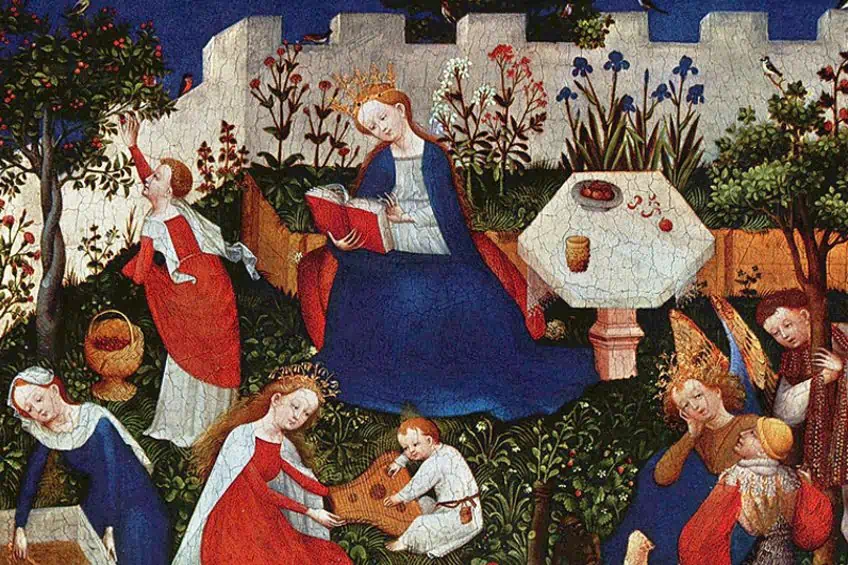Famous Medieval Paintings – Discover Middle Ages Paintings
The Medieval art era, spanning many years and the rise and fall of many kingdoms all over Europe, started around the fall of the Roman Empire and only ended around 1500 A.D. Despite the vast difference in location and time between many of the most important Medieval artworks, most of them are linked because of a focus on Christian religious imagery, with shared symbolism, and a move away from the Romanesque period of structured formulas for the depiction of religious imagery. The function of Medieval artworks was to glorify and spread the message of the Christian belief, but there was also a formal focus on attempting to create three-dimensional and true-to-life depictions of the human form. Today, we are looking at ten of the most famous Medieval paintings in history.
What Are Traits of the Medieval Art Period?
The Medieval period in art was marked by the use of elaborate patterns, the symbolic use of color, and the inclusion of large areas of gold in paintings. Artists were starting to experiment with perspective and three-dimensionality. Many of the human figures in their paintings were not true-to-nature depictions, but there was a growing attempt to find the best possible way to depict people as naturalistic (resembling real people).
The Medieval artists were slowly breaking away from the formal religious painting styles of the previous eras. Medieval paintings are classified into different types of paintings – including fresco and panel painting.
Frescoes are mural paintings on wet lime plaster – where wet lime is mixed with the paint and merged with the wall as if they were seamless. Panel paintings were made on flat panels typically made out of wood. There are other types of media that the Medieval artists used for their work, such as mosaic, sculpture, and illuminated manuscripts.
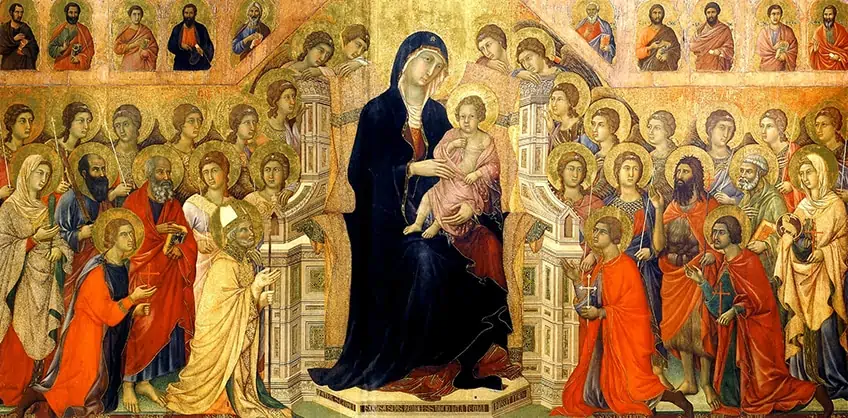
Ten of the Most Important Medieval Artworks
The Medieval period spanned almost a thousand years of art-making, and there are many important artworks in this period. We are focusing on only ten of the most important artworks created by some of the most important Medieval painters.
It is important to note that while most of these artists are male (or unknown), there were women who created art in the Middle Ages. However, these are hard to track down or research because most female artists of the time were nuns who painted illuminated manuscripts. Claiming the esteem for their work was not important, as they created artworks as a religious exercise.
Diptych of the Virgin and Child Enthroned and the Crucifixion (1275 – 1280) by Unknown
| Artist | Unknown |
| Date Painted | 1275-1280 |
| Medium | Panel painting |
| Dimensions | Two panels of 38 cm × 29.5 cm each |
| Where It Is Currently Housed | Art Institute of Chicago |
This diptych is an earlier example of Medieval painting. It is made of two panel paintings put together with hinges. This mysterious painting is very simplistic compared to some of the busy artworks we will see later in this list. The left panel shows the Virgin Mary seated, holding the baby Jesus. The right panel shows the crucifixion, with two mourners at his side.
These are most likely the Virgin Mary and Mary Magdalene or John the Baptist.

Both panels have cherubs hovering on either side of the central figures. This diptych is small and portable, and the history of the painting is that it was likely painted in Acre, a Crusader outpost where artists specialized in creating holy images. These were made small so that travelers could take their artworks wherever they went. The person who bought the artwork is painted on the left of the Virgin Mary.
This artwork shows an interest in making the work three-dimensional, but it is still quite flat. The throne and cross have almost no experimentation with perspective.
Christ’s crucified body, as well as the mourning people, are depicted very emotionally. The Virgin Mary is comforting herself, the other person weeping into their hand, and Christ’s face shows an immense amount of emotion. Although the bodies are not very naturalistic, the emotions captured in them are truly stunning!
Santa Trinita Maestà (1283 – 1291) by Cimabue
| Artist | Cimabue (1240-1302) |
| Date Painted | 1283–1291 |
| Medium | Panel painting |
| Dimensions | 385 cm × 223 cm |
| Where It Is Currently Housed | Uffizi Gallery, Florence, Italy |
Cimabue, said to be the teacher of Giotto, one of the artists we will learn about soon, also depicted the Madonna with the baby Jesus. Cimabue’s Santa Trinita Maestà is another beautiful Medieval painting of the scene of the mother Mary and the baby Jesus. Cimabue’s figures are also an attempt at greater naturalism, but not yet as pronounced as in the work of Giotto. The Madonna is shown dressed in blue, seated on a detailed throne, holding the oddly proportioned baby Jesus.
This is another classical feature of Medieval art – the distortion of the bodies of babies. The proportions of the baby Jesus are more similar to that of an adult figure, with long arms and legs, but an oversized head. This baby Jesus is also shown with a halo around his head, as are all of the other Biblical figures in the painting. This was an easy way for artists to show us who was a saint or an angel.
The Mother Mary also has a halo. She is the center of the panel, directly beneath the middle point of the painting. There are four angels on each side of the Madonna, with the figures in symmetrical poses, the bottom ones’ hands angling down and toward the other.

The other angels’ hands point upwards. This type of composition is designed to always lead our eyes back to the main figures. The throne offers a greater sense of depth, due to the diagonal lines disappearing behind the seated figure. The people at the bottom of the painting are prophets.
This artwork has a disputed timeline, as is often seen in Medieval art examples. This sort of debated timeline has to be worked out by looking at the artist’s other work with recorded histories, and comparing the progression in style and skill.
This particular Medieval artwork was compared with Cimabue’s artwork Maestà di Assisi (1285-1288), where similar effects were created in the folds of the clothing, as well as in the way he created a size difference between Mary and the other figures in the painting.
Lamentation (The Mourning of Christ) (1304 – 1306) by Giotto
| Artist | Giotto di Bondone (1267-1337) |
| Date Painted | 1304-1306 |
| Medium | Fresco |
| Dimensions | 200 cm x 18 cm |
| Where It Is Currently Housed | Scrovegni Chapel, Padua, Italy |
Focused on the life of Christ and his apostles, the artist known as Giotto was one of the most notable artists of the period. Lamentation (The Mourning of Christ) is one of the most notable paintings of the entire Medieval art era.
We are looking at three of Giotto’s artworks today, as his artworks were truly beautiful Medieval art examples. This fresco is painted in the Scrovegni Chapel in Padua, Italy. It was painted directly onto the interior north wall of the chapel, along with many other religious scenes, in a series entitled The Life of Christ.
The painting depicts the moment just after Christ’s death, when the apostles and the Virgin Mary were holding the body of the deceased Christ. The figures in the foreground present are crowned with golden halos. Behind them, a group of mourners is standing with their heads bent.
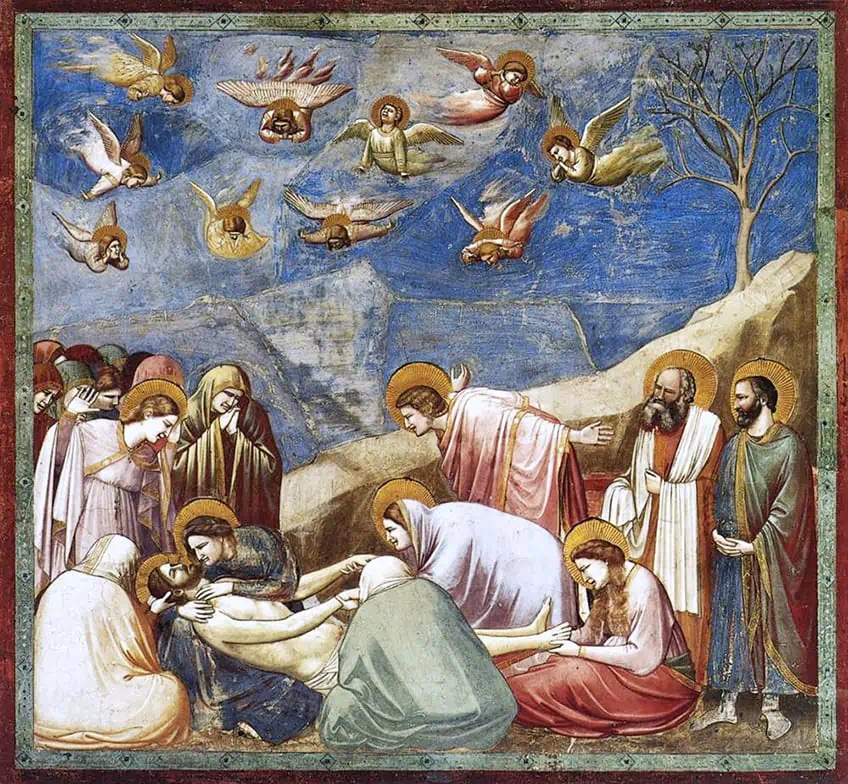
Above them, on a textured blue background, ten angels are flying, with golden wings and blurred feet. The angels’ presence along with the normal people connects Christ with both Heaven and humanity. There is also a withered tree in the background, symbolizing the death of Christ and the tragedy of that event.
This work defies the norms of earlier Byzantine era artwork because of the naturalistic style in which it was painted – with figures and faces rounded by shadows and shading.
Another important aspect of this painting is the emotion depicted in the faces of the mourners and the angels, some displaying a lot of drama in their pain, such as the figure (believed to be John the Baptist) with his arms thrown wide and his face contorted in agony.
The background also includes a sense of perspective due to the diagonal line of the horizon. This creates a sense of space not often seen in the previous Byzantine art. Lamentation is a Medieval artwork showing a break from the tradition of more one-dimensional artworks.
The Arrest of Christ (Kiss of Judas) (1306) by Giotto
| Artist | Giotto di Bondone (1267-1337) |
| Date Painted | 1306 |
| Medium | Fresco |
| Dimensions | 200 cm x 185 cm |
| Where It Is Currently Housed | Scrovegni (Arena) Chapel, Padua, Italy |
This special composition is truly a masterpiece in creating movement, especially for a Medieval painting. Giotto here depicted the moment where Judas betrayed Christ with a kiss, leading to his arrest and crucifixion. There are multiple areas of movement in this piece. Centrally, there is the movement in Judas’ robe, his face caught in the moment before the fated kiss. The Christ figure, knowing what will happen, seems calm despite the chaos around them.
In this painting, Judas and Christ are caught in an intense moment.
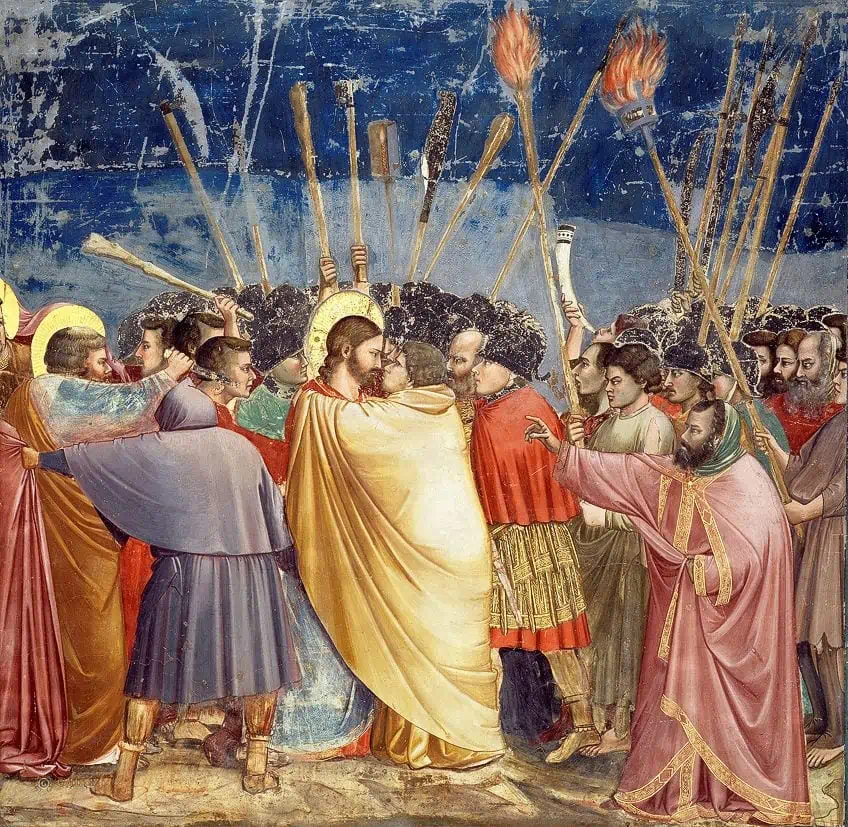
There is also movement in the foreground figures, especially in the man in pink who points to the two main figures, his arm leading the eye back to Christ and Judas. The sticks and weapons held in the air by all the figures also create a sense of movement due to the diagonal lines.
The depth in this fresco is also extraordinary. The people, moving past and painted halfway behind or in front of each other, create a sense of depth and space.
There is also roundness in their faces and clothing, especially in the foreground of the painting. There is a lot of emotional quality in the work. There is anger and fear among the background figures, as well as accusation in the soldiers’ faces and mannerisms.
But we are mostly left with a sense of the betrayal and pain happening between the two main figures. Judas seems intent on his action, but immediately regrets what he did afterward, while Jesus seems calm in the chaotic scene – possibly saddened but accepting of what will happen next.
The intensity of the moment is truly captured by Giotto, one of the most notable Medieval artists.
Ognissanti Madonna (1310) by Giotto
| Artist | Giotto di Bondone (1267-1337) |
| Date Painted | 1310 |
| Medium | Panel painting |
| Dimensions | 325 cm x 204 cm |
| Where It Is Currently Housed | Uffizi Gallery, Florence, Italy |
Madonna Enthroned, or the Ognissanti Madonna, is one of Giotto’s other most famous Medieval paintings. There is some debate as to whether Giotto made this artwork or if it was one of his apprentices, but the work is credited to him. This graceful painting of the Virgin Mary holding the baby Jesus is very well preserved and a great example of the artist’s obsession with depicting figures as three-dimensional.
This painting features the Madonna, a large figure on a throne, surrounded by angels and other figures from the Bible. The baby Jesus is once again oddly proportioned, and notably, his hand looks comically small compared to his mother’s hands.
This also shows the typical way that the Virgin Mary was depicted – in blue. This was the traditional way to depict Virgin Mary due to her purity. The color blue was preserved for only the holiest people in Middle Ages paintings. The color blue was very rare, due to the rarity of the stone with which it was made – lapis lazuli.

The folds of Mary’s clothing are also very realistic, a marker of the movement towards greater naturalism in artistic style. The focus on the naturalistic style is still characterized by the stiffness of the figures, which was typical of the Byzantine era.
The painting is focused on symmetry, with the saints on the side almost identical to each other, while the Madonna and baby Jesus are the main focus. Many of the smaller figures look directly up at them, while the darker shade of Madonna’s cloak also emphasizes the Virgin Mary.
The baby Jesus’s hand also points towards her face, and so she becomes the true focal point of the artwork. The Madonna Enthroned is truly a beautiful example of the style of the artist Giotto (or at least, we think it was made by him!).
Christ Rescuing Peter from Drowning (1370) by Lorenzo Veneziano
| Artist | Lorenzo Veneziano (1336-1379) |
| Date Painted | 1370 |
| Medium | Panel painting |
| Dimensions | 25 x 63 cm |
| Where It Is Currently Housed | Staatliche Museum, Berlin |
Depicting one of the most commonly known scenes from the Bible, Lorenzo Veneziano painted this scene of Jesus walking on water to save Peter while the other disciples are waiting inside the fishing boat. The focus of this painting is to the far right, where Christ holds onto Peter’s wrist.
The lines of the figures in the boat and the sails of the ship all lead back to Christ and Peter.

There is movement in those lines. Arms pointing are diagonal, and the circling shape of the sails and the waves underneath the ship all create a beautiful sense of movement. Some parts of the background are gold-ground. Gold-ground is a typical Middle Ages painting technique wherein the entire background is covered in gold leaf.
In this painting, there are sections of gold-ground, and others are a blueish hue to depict the water of the sea. And on the left of the composition is a man sitting on land, fishing. This man is an interesting part of the painting.
Possibly the man could signify that humanity is all included in the message of the painting, which was to have faith in Christ.
The Wilton Diptych (1395 – 1399) by the Wilton Master
| Artist | The Wilton Master |
| Date Painted | 1395-1399 |
| Medium | Panel painting |
| Dimensions | Two panels of 53 cm x 37 cm each |
| Where It Is Currently Housed | The National Gallery, London |
The Wilton Diptych is a small diptych panel painting connected by hinges. The author of this artwork is unnamed, but generally known as the Wilton Master. This painting was created for King Richard II of England, who is in the painting himself as the figure kneeling before the Virgin Mary and baby Jesus. He is presented to the holy baby by two English saints, as well as John the Baptist. This type of painting is called a donor painting, where the patron of the artist is painted into the artwork. In this case, King Richard II is the donor. This can also be seen in some of the other paintings on this list.
The Wilton Diptych was made in tempera. This is a mixture of egg yolk and colored pigments – a technique that existed long before oil painting became prominent. This diptych also has big areas covered in gold leaf.
The figures in the right panel are wearing blue. The Virgin Mary is once again depicted with blue, and the angels in this painting are also wearing blue. King Richard’s clothing is painted with vermillion. Both the use of lapis lazuli (for the blue) and vermillion show that this was an extremely expensive painting to make.
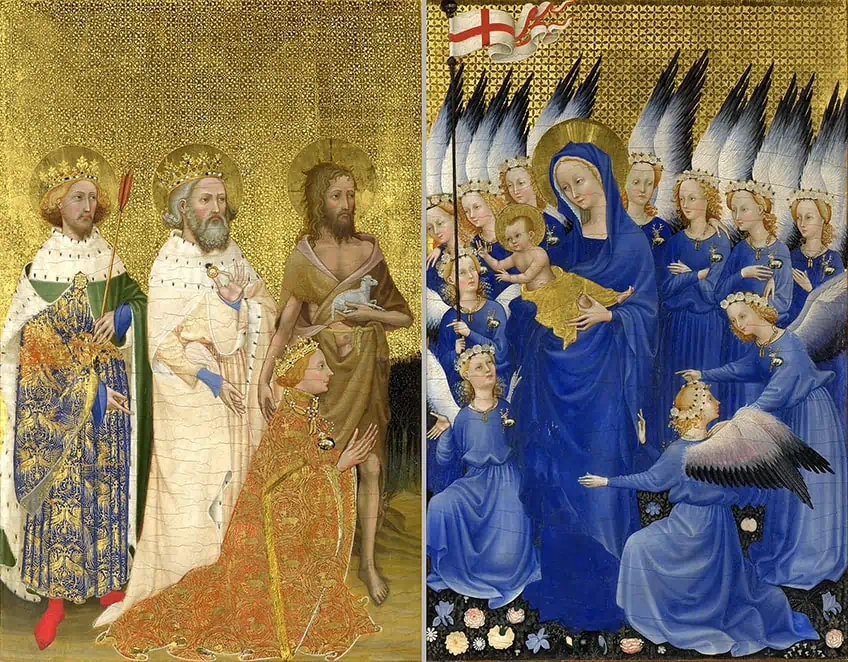
There are spaces in the background where the artist also worked into the panel, and then covered it with gold. This creates a sense of great detail in the painting. The pattern in the gold was made with a metal punch. The background in the right panel is decorated with a different pattern made in the same way.
In the right panel, the Virgin Mary is holding the baby Jesus, and they are surrounded by 11 angels. They stand on a green field covered in flowers, while the people in the left panel are on bare ground. There is a lot of symbolism in the clothing of the people in the left panel, with much to identify the king and saints, such as the white hart of King Richard II.
The two panels are quite different. The left panel is calm and formal, while on the right, there is a lot of movement and energy. The angels’ wings and the folds of their clothing create a large tonal contrast, making the scene very three-dimensional. There is also a great amount of naturalism in their faces.
On the right, the darker background also creates a sense of space. This is also done with the folds in the saints’ clothing. There is a sense of respect for what the King is witnessing in the other panel, and the emotional quality of this Medieval painting also echoes this.
Paradiesgärtleins (1410) by Upper Rhenish Master
| Artist | Upper Rhenish Master |
| Date Painted | 1410 |
| Medium | Panel painting |
| Dimensions | 26.3 cm × 33.4 cm |
| Where It Is Currently Housed | Städel, Frankfurt, Germany |
The Paradiesgärtleins, meaning the “Garden of Paradise”, is one of the most vividly colored panel paintings on our list. The painting was made by another unknown artist, referred to as the Upper Rhenish Master, late in the Medieval era. The Paradiesgärtleins is one of the earlier artworks known to depict fauna and flora. There are 24 plant and 12 bird species. The garden shows the Virgin Mary seated, reading a book, while saints are gathered enjoying the garden.
The sense of space in the artwork is notable. The diagonal line of the wall created a squared sense of the garden. There is also an attempt to make the furniture three-dimensional, particularly the table next to Mary. The cup and bowl on the table are a notable little detail that shows the artist’s interest in creating perspective.
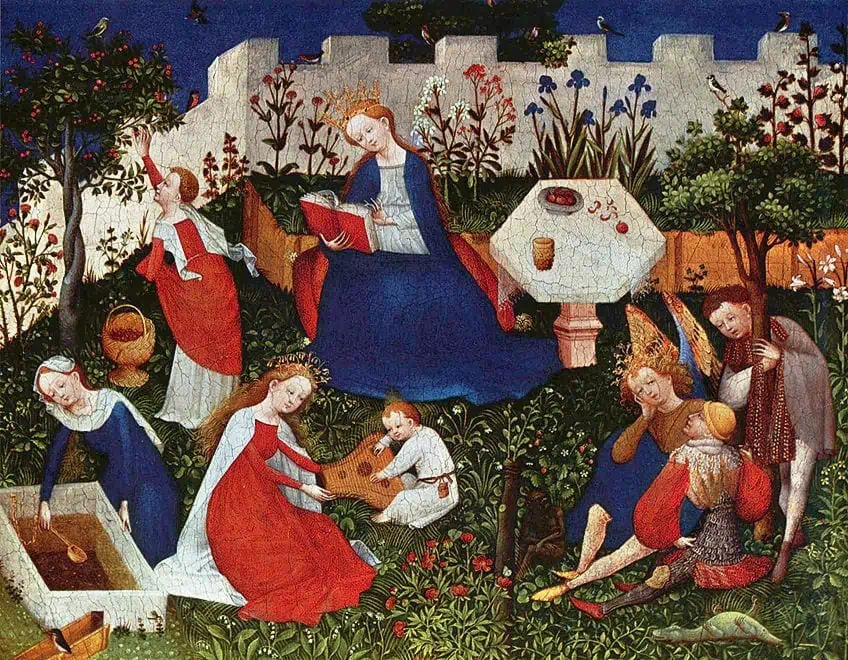
There is an amazing sense of roundness of the figures, with shading and different angles which show that the artist was attempting to create a naturalistic effect. The plants and birds are also shaded, and some of the leaves in the trees jump out while others are darker and recede into the background. The tree in the left corner of the panel is another beautiful attempt at three-dimensionality.
Thematically the Garden of Paradise relates both to a gathering in paradise, but also to what is known as the Hortus Conclusus, or the closed garden. This is an allusion to Mary’s virginity. These themes weave together with the real imagery of the garden to create a beautifully tranquil scene.
The Trinity (c. 1411 – 1427) by Andrei Rublev
| Artist | Andrei Rublev (1360-1430) |
| Date Painted | 1411 or 1425–1427 |
| Medium | Panel painting |
| Dimensions | 142 cm × 114 cm |
| Where It Is Currently Housed | Tretyakov Gallery, Moscow, Russia |
Andrei Rublev was a Medieval artist from Russia, in the years just before the Renaissance sprung to life in Italy. The Trinity is considered one of the most important creations in Russian art. It is considered an icon of the Holy Trinity, but also shows three angels who went to Abraham, another story in the Bible. The angels are shown sitting at a table.
Their bodies are arranged so that the lines of their bodies form a circle, keeping the viewer’s eye moving across their bodies. This circular composition is a part of the symbolism of the Holy Trinity. The figures are still and calm, with a bit of shading to show their three-dimensionality, and a lot of attention is paid to the detail of their clothing.
There is a building behind the angel on the left, likely the house of Abraham. The building shows an interest in perspective, which we can see because we can see more than one side of it. There is a front angle of the building, but with diagonal lines, the artist has shown the bottom as well as one side of the building, just as our eyes would have seen it.

The tree and the mountain on the right side of the background likely refer to the Oak of Mamre and Mount Moriah. On the table between the Trinity is a bowl containing a calf’s head. The painting follows the story that three angels visited Abraham, and he slaughtered a calf to celebrate their visit. They then announced that his wife would soon give birth to a son.
This painting was made to honor Saint Sergius of Radonezh. He had been an important Russian religious leader. This wonderful piece was so precious that Ivan the Terrible commissioned a riza to be made for the painting. The riza, a golden cover for an icon, was made to protect it.
The rizas were made with gaps in them so that parts of the icon could still be seen, and the faces of the three angels were still displayed by the riza. This artwork has been copied twice, and more rizas were commissioned for them at those times, with each one different and celebrating this beautiful Medieval painting in their own ways.
The Ghent Altarpiece (1432) by Hubert and Jan van Eyck
| Artist | Hubert van Eyck (1370-1426) and/or Jan van Eyck (1390-1441) |
| Date Painted | 1432 |
| Medium | Panel painting |
| Dimensions | 5.2m x 3.75m |
| Where It Is Currently Housed | Saint Bavo Cathedral, Ghent, Belgium |
Known as the most stolen piece of art in history, the Dutch Medieval artists Hubert and Jan van Eyck’s Ghent Altarpiece is likely one of the most famous Medieval artworks. The van Eyck’s were brothers who worked together, although there is some debate about which brother made this masterpiece. The Ghent Altarpiece is known as a polyptych – an artwork that consists of multiple pieces which make a larger picture together. This polyptych consists of multiple panel paintings, each depicting an instance or person from the Bible, with Old and New Testament scenes.
The inner altarpiece is made up of two vertical sections, or registers, with two big paintings in the middle, and smaller sections attached on each side which can fold out into the unique composition that you can see in the artwork.
The central panel shows the classical enthroned God, with the Virgin Mary and John the Baptist next to him. The panels next to them on both sides show angels making music, while the panels at the ends depict Adam and Eve separately. The bottom register’s middle panel displays the adoration of the Lamb of God, a classical name for Christ. The Lamb of God is surrounded by angels, and other figures in the panel include clergy, martyrs, prophets, writers, and saints. In the center is the fountain of life, and the scene is filled with other religious imagery.
On the wing, panels are approaching figures. These are knights and judges. The presence of the judges has long confused historians, as the depiction of them was considered an anomaly in the era.
The open section of The Ghent Altarpiece (1432) by Hubert and Jan van Eyck; Jan van Eyck, Public domain, via Wikimedia Commons
When the altarpiece is closed, there is a different image painted on the outside, which is called the closed view. In the closed view of the altarpiece, we can see different figures depicted in much detail. The top figures hold scrolls and books and are believed to be prophets and sibyls who foretold that Christ would be born. The middle section displays the angel, Gabriel. He is relaying the message that the Virgin Mary will give birth to Christ.
There is some empty space that suggests a symbolic space for Christ to come, but it is also a beautiful example of perspective and space created by Medieval artists.
The bottom section depicts two people and two sculptures. This creates a very interesting trick, as we would think that only the people in red could be real people, while all of them are just paintings. The sculpture figures are the two Saint Johns, while the figures in red are the patrons who paid for the artists to create the altarpiece.
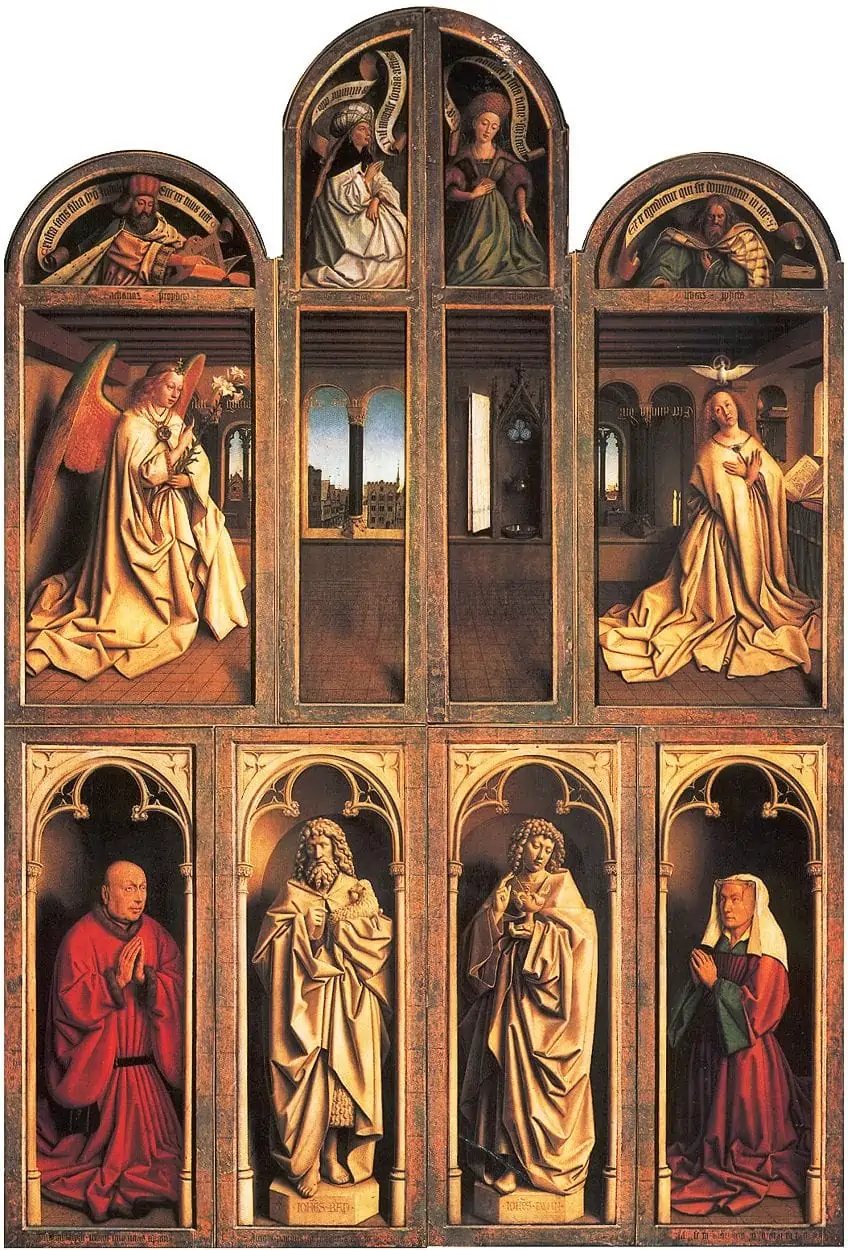
The altarpiece contains intense attention to detail. There is depth in the figures and the objects, as well as a sense of three-dimensionality that shows that artists wanted to capture the naturalistic human form. The details are truly stunning, showing the care the artists gave to the furniture and objects to show the grandeur of the heavenly, as well as the vulnerability of the human figures such as Adam and Eve.
The painting in its totality makes us pause and take our time to look at every detail, as it is impossible to take it all in with just one glance.
This effect symbolizes the vision of God, which is capable of seeing all at once (including the vast details of the background landscapes), while human eyes cannot possibly do the same. This masterpiece was stolen many times throughout history and we are really lucky to be able to look at it today!
Today we have seen ten of the most influential and important Medieval artworks. Although the artworks have many things in common – such as their religious themes and certain stylistic norms – they also show that there was a lot of diversity in the artist’s depictions. From very simplistic, flat paintings, to highly detailed and emotionally intense artworks, Medieval artists showed a longing for growth and development in their skills and styles. The Medieval art period ended when the Renaissance began and artists could truly focus on creating with a previously unimagined freedom!
Take a look at our Medieval paintings webstory here!
Frequently Asked Questions
What Did Medieval Artist Use to Paint With?
The tempera mixture of paint included using pigments found in the earth, such as red ochre, umber, lime, lapis lazuli, and vermillion, mixed with a binding material such as egg yolks.
When Was the Medieval Period?
Between the years 500 A.D. and 1500 A.D. spans all of the Medieval art period. The majority of the most famous works of art came from the later stage of the Medieval era, which was known as the Gothic Era.
Who Was the Most Influential Medieval Artist?
Giotto, who was part of the late Medieval art period, was one of the most important Medieval painters. Many of his paintings are considered to be some of the most important Medieval art examples to exist today.
Jordan Anthony is a Cape Town-based film photographer, curator, and arts writer. She holds a Bachelor of Art in Fine Arts from the University of the Witwatersrand, Johannesburg, where she explored themes like healing, identity, dreams, and intuitive creation in her Contemporary art practice. Jordan has collaborated with various local art institutions, including the KZNSA Gallery in Durban, the Turbine Art Fair, and the Wits Art Museum. Her photography focuses on abstract color manipulations, portraiture, candid shots, and urban landscapes. She’s intrigued by philosophy, memory, and esotericism, drawing inspiration from Surrealism, Fluxus, and ancient civilizations, as well as childhood influences and found objects. Jordan is working for artfilemagazine since 2022 and writes blog posts about art history and photography.
Learn more about Jordan Anthony and about us.
Cite this Article
Jordan, Anthony, “Famous Medieval Paintings – Discover Middle Ages Paintings.” artfilemagazine – Your Online Art Source. February 15, 2022. URL: https://artfilemagazine.com/famous-medieval-paintings/
Anthony, J. (2022, 15 February). Famous Medieval Paintings – Discover Middle Ages Paintings. artfilemagazine – Your Online Art Source. https://artfilemagazine.com/famous-medieval-paintings/
Anthony, Jordan. “Famous Medieval Paintings – Discover Middle Ages Paintings.” artfilemagazine – Your Online Art Source, February 15, 2022. https://artfilemagazine.com/famous-medieval-paintings/.


